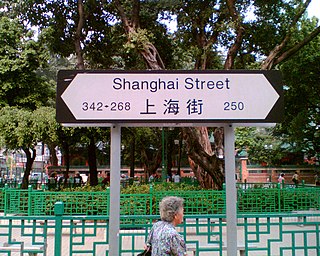
Yau Tsim Mong District is one of 18 districts of Hong Kong, located on the western part of Kowloon Peninsula. It is the core urban area of Kowloon. The district has the second highest population density of all districts, at 49,115 km2 (18,963 sq mi). The 2016 By-Census recorded the total population of Yau Tsim Mong District at 342,970.

The Hong Kong local elections are elections in Hong Kong for the members of District Councils. First held in 1982, the elections are held at 4-year intervals for returning a total of 452 elected members as at 2019. The last election was held on 24 November 2019.

Middle Road is a street in the southern part of Tsim Sha Tsui, Kowloon, Hong Kong.

Shanghai Street is a 2.3 km long street in the Jordan, Yau Ma Tei and Mong Kok areas of Kowloon, Hong Kong, China. Completed in 1887 under the name of Station Street (差館街), it was once the most prosperous street in Kowloon. It originates from the south at Austin Road, and terminates in the north at Lai Chi Kok Road. Parallel to Shanghai Street are Nathan Road, Temple Street, Portland Street, Reclamation Street and Canton Road. Though parallel, Shanghai Street was marked by 2- to 3-floor Chinese-style buildings while Nathan Road was marked by Western-style buildings.
Articles related to Hong Kong include:

KMB Route 1A is a bus route operated by Kowloon Motor Bus (KMB) in Hong Kong. It runs between Star Ferry and Sau Mau Ping (Central) and provides air-conditioned service. The route runs via Tsim Sha Tsui, Yau Ma Tei, Mong Kok, Kowloon City, San Po Kong, Ngau Tau Kok, Kwun Tong, and Sau Mau Ping.

Island Harbourview is one of the largest private housing estates in Tai Kok Tsui, Yau Tsim Mong District, Kowloon, Hong Kong. It is one of the property projects in MTR Olympic station Phase I. Developed by MTR Corporation, Sino Land, Bank of China, Kerry Properties, China Overseas Land and Investment and Capitaland Commercial Limited, it comprises nine high-rise buildings, which were completed in 1998 and 1999. The towers are numbered from one to ten, but there is no tower four due to local superstition.

Metro Harbour View is a private housing estate at the intersection of Tai Kok Tsui Road and Fuk Lee Street in Tai Kok Tsui, Kowloon, Hong Kong, within walking distance to the MTR Olympic station.

The Yau Tsim Mong District Council is the district council for the Yau Tsim Mong District in Hong Kong. It is one of 18 such councils. The Yau Tsim Mong District Council currently consists of 20 members, of which the district is divided into two constituencies, electing a total of 4 members, 8 district committee members, and 8 appointed members. It was merged from the Mong Kok District Board and Yau Tsim District Board in 1994 due to the significant drop of the population in the districts. The latest election was held on 10 December 2023.
The 2012–13 Hong Kong Junior Challenge Shield is the 85th season of the Hong Kong Junior Challenge Shield, a knock-out competition for Hong Kong's 40 football clubs playing below the top-tier division league. Wanchai are the defending champions, having beaten Happy Valley in the 2012 Final.
Jackie Chan Chai-keung is a former member of the Legislative Council of Hong Kong and Mong Kok District Board.

The Ibrahim Mosque is a mosque in Mong Kok, Hong Kong. It is the sixth and latest mosque built in Hong Kong. The mosque was constructed and is managed by the United Welfare Union Hong Kong Limited.
Kowloon West Cluster is the largest among all seven hospital clusters managed by Hospital Authority in Hong Kong. It consists of five public hospitals and 16 general outpatient clinics to provide public healthcare services for the population of Wong Tai Sin, Mong Kok, Sham Shui Po, Kwai Tsing, Tsuen Wan and North Lantau. In mid-2012, the population was 1,887,600. The current Cluster Chief Executive is Dr Doris Tse Man-wah.

The Tsim Sha Tsui Waterfront Revitalisation Plan is a forfeited development proposal by New World Development Co. Ltd and the Leisure and Cultural Services Department made in 2013. The aim of the plan was to reshape the waterfront by adding in activity hubs consisting of various small-scale commercial, entertainment and recreational areas in Salisbury Garden, Avenue of Stars as well as the East Tsim Sha Tsui Promenade. The plan was later dismissed by Leisure and Cultural Services Department and the Harbourfront Commission due to huge public controversies in 2016.

The District Officer is a directorate public officer and a head of the District Office in Hong Kong. The District Officer (DO) is also the top representative of the Hong Kong Government at the district level. The positions of the District Officers were established in urban Hong Kong, Kowloon and New Kowloon in 1968. DOs have served as the commanders of Care Teams in 18 political areas since 2023, and as chairmen of District Councils from 2024. The District Officer is assisted by the Assistant District Officer (ADO), who is an administrative officer (AO) or a senior administrative officer (SAO). All DOs are appointed to the "Justices of the peace" (JP) by the Chief Secretary for Administration or Chief Executive of Hong Kong by convention.














